2004 VOLVO XC90 fuel pressure
[x] Cancel search: fuel pressurePage 145 of 245

2004 VOLVO XC90
road holding on slippery surfaces than tires without the "all-season" ra\
ting.
However, for optimum road holding on icy or snow-covered roads, we recom\
mend suitable winter tires
on all four wheels. When replacing tires, be sure that the new tires are\
the same size designation, type
(radial) and preferably from the same manufacturer, on all four wheels\
. Otherwise there is a risk of
altering the vehicle's roadholding and handling characteristics.
NOTE: When storing wheel/tire assemblies (e.g. winter tires and wheels), eit\
her stand the assemblies
upright, or suspend them off the ground. Laying wheel/tire assemblies on\
their sides for prolonged
periods can cause wheel and/or tire damage.
New tires
Remember that tires are perishable goods. As of 2000, manufacturing year\
and week will be indicated
with 4 digits (e.g. 1502 means that the tire is manufactured year 2002,\
week 15).
Improving tire economy:
l Maintain correct tire pressure. See the tire pressure label on the insid\
e of the fuel filler door.
l Drive smoothly: avoid fast starts, hard braking and tire screeching.
l Tire wear increases with speed.
l Correct front wheel alignment is very important.
l Unbalanced wheels impair tire economy and driving comfort.
l If tires are rotated, they must be kept on the same side of the vehicle \
so that they revolve in the same
direction as before rotation.
l Hitting curbs or potholes can damage the tires and/or wheels permanently\
.
Flat spots
All tires become warm during use. After cooling, when the vehicle is par\
ked, the tires have a tendency to
distort slightly, forming flat spots. These flat spots can cause vibrati\
ons similar to the vibrations caused
by unbalanced wheels. They do, however, disappear when the tire warms up\
. The degree to which flat
spots form depends on the type of cord used in the tire. In cold weather\
, it takes longer for the tire to
warm up and consequently longer for the flat spot to disappear.
file:///K|/ownersdocs/2004/2004_XC90/04xc90_08.htm (2 of 13)12/30/2006\
4:35:25 PM
Page 147 of 245

2004 VOLVO XC90
Volvo recommends 225/70 R16 (235/65 R17 on seven-seat models with the T\
6 turbo engine) winter
tires on all four wheels.
Winter tires wear more quickly on dry roads in warm weather. They should\
be removed when the winter
driving season has ended.
Studded tires should be run-in 300 - 600 miles (500 - 1000 km) during \
which the vehicle should be
driven as smoothly as possible to give the studs the opportunity to seat\
properly in the tires. The tires
should have the same rotational direction throughout their entire lifeti\
me. In other words, if you wish to
rotate the wheels, make sure that the same wheels are always on the same\
side of the vehicle.
NOTE: Please consult state or provincial regulations restricting the use of st\
udded winter tires before
installing such tires.
* Where permitted
pg. 110 Wheels and tires
Tire pressure
Tire pressure label
Checking and correcting tire pressure
The tire pressure label is located on the inside of the fuel filler door\
.
l Check the tire pressure regularly.
l The tire pressure should be corrected only when the tires are cold.
file:///K|/ownersdocs/2004/2004_XC90/04xc90_08.htm (4 of 13)12/30/2006\
4:35:25 PM
Page 148 of 245

2004 VOLVO XC90
l With warm tires, correct only when the pressure is too low. The tire tem\
perature rises after driving
just a few miles.
Vehicle loading
The tires on your Volvo will perform to specifications at all normal loa\
ds when inflated as
recommended on the tire information label located on the inside of the f\
uel filler door. This label lists
both tire and vehicle design limits. Do not load your vehicle beyond the\
load limits indicated.
WARNING!
Improperly inflated tires will reduce tire life, adversely affect vehicl\
e handling and can possibly lead
to failure resulting in loss of vehicle control without prior warning.
Temporary Spare
The spare tire in your vehicle is called a "Temporary Spare".
Recommended tire pressure (see decal on Fuel filler door) should be ma\
intained irrespective which
position on the vehicle the Temporary Spare tire is used on. In the even\
t of damage this tire, a new one
can be purchased from your Volvo retailer.
WARNING!
Current legislation prohibits the use of the Temporary Spare" tire other\
than as a temporary
replacement for a punctured tire. It must be replaced as soon as possibl\
e by a standard tire. Road
holding and handling may be affected with the "Temporary Spare" in use. \
Do not exceed 50 mph (80
km/h). Do not drive farther than 50 miles (80 km) on a temporary spar\
e tire.
CAUTION
The vehicle must not be driven with wheels of different dimensions or wi\
th a spare tire other than the
one that came with the vehicle. The use of different size wheels can ser\
iously damage your vehicle's
transmission.
The temporary spare tire is for temporary, low-speed, short-distance use\
only. Replace it with a full-
sized tire as soon as possible, in accordance with "Tire Rotation" in th\
e previous paragraph. Do not drive
on the temporary spare at speeds above 50 m.p.h. (80km/h) or for dista\
nces greater than 50 miles (80
km).
Never install snow chains on a temporary spare.
NOTE: Certain models may be equipped with a full-size spare tire. When used, i\
t should be inflated to
file:///K|/ownersdocs/2004/2004_XC90/04xc90_08.htm (5 of 13)12/30/2006\
4:35:25 PM
Page 195 of 245

2004 VOLVO XC90
Label information
1 Vehicle Emission Control Information
Your Volvo is designed to meet all applicable emission standards, as evi\
denced by the certification label
on the underside of the hood. For further information regarding these re\
gulations, please consult your
Volvo retailer.
2 Vacuum hose routing
(underside of hood)
3 Loads and Tire Pressures
(on inside of fuel filler door)
4 Model plate
Vehicle Identification Number (VIN). Codes for color and upholstery, e\
tc. The plate is located in the
engine compartment, on the inside of the left front fender.
file:///K|/ownersdocs/2004/2004_XC90/04xc90_10.htm (2 of 11)12/30/2006\
4:35:29 PM
Page 203 of 245

2004 VOLVO XC90
B5254T2 B6294T
Output (kW/rps) 154/83 200/85
- (hp/rpm) 208/5000 268/5100
Torque (Nm/rps) 320/25-75 380/30-83
- (ft. lbs./rpm) 236/1500-4500 280/1800-5000
No. of cylinders 5 6
Bore (mm) 83 83
Stroke (mm) 93.2 90
Cylinder displacement,
liters 2.52 (153.8 cu
in)
2.92 (178.3 cu in)
Compression ratio 9.0:1 8.5:1
Charge air cooler (Intercooler)
Turbocharged engines employ a turbo-compressor to force air into the eng\
ine inlet manifold and a
charge air cooler to cool the compressed inlet air. The resulting increa\
se in air flow raises pressure in the
intake manifold and increases engine power over that developed by the no\
rmally-aspirated engine. The
charge air cooler (which resembles a radiator) is located between the \
turbo-compressor and inlet
manifold.
Fuel system
The engine is equipped with a multiport fuel injection system.
pg. 157 Specifications
Volvo On Call Roadside Assistance
Your new Volvo comes with a four year ON CALL roadside assistance. Addit\
ional information,
features, and benefits are described in a separate information package i\
n your glove compartment.
If you have misplaced your package, dial:
In the U.S.A.
1-800-638-6586 (1-800-63-VOLVO)
In Canada:
1-800-263-0475
Technician certification
In addition to Volvo factory training, Volvo supports certification by t\
he National Institute for
Automotive Excellence (A.S.E.). Certified technicians have demonstrate\
d a high degree of competence
in specific areas. Besides passing exams, each technician must also have\
worked in the field for two or
more years before a certificate is issued. These professional technician\
s are best able to analyze vehicle
file:///K|/ownersdocs/2004/2004_XC90/04xc90_10.htm (10 of 11)12/30/200\
6 4:35:29 PM
Page 244 of 245

2004 VOLVO XC90
2. Power steering - When cold, the level must not be above the COLD mark\
and when hot it must not be
above the HOT mark. Top up if the level drops to the ADD mark with ATF f\
luid. See
page 130.
3. Coolant level should be between the expansion tank marks. Mixture: 50\
% antifreeze and 50% water.
See
page 125.
4. Engine oil should be checked each time the vehicle is refueled. The o\
il level should be between the
dipstick marks. The distance between the marks represents approx. 1.6 US\
qt. (1.5 liter). See
page 128.
5. Brake fluid - check, without removing the cap, that the level is abov\
e the MIN mark. Use brake fluid
DOT 4+. See
page 130.
Fuel octane rating, see
page 82.
Tire pressure, see
page 110, and the label located on the inside of the fuel tank cover.
1 Turn signal H21W amber
2 High beam 55W H7
3 Parking light W5W
4 Low beam 55W H7
5 Fog light, front 55W H1
6 Fog light, rear 21W BA5
7 Back-up light 21W BA15
8 Parking light/tail
light P21 4W
9 Turn signal PY21W amber
10 Brake light 21W BA15
file:///K|/ownersdocs/2004/2004_XC90/04xc90_12.htm (12 of 13)12/30/200\
6 4:35:33 PM